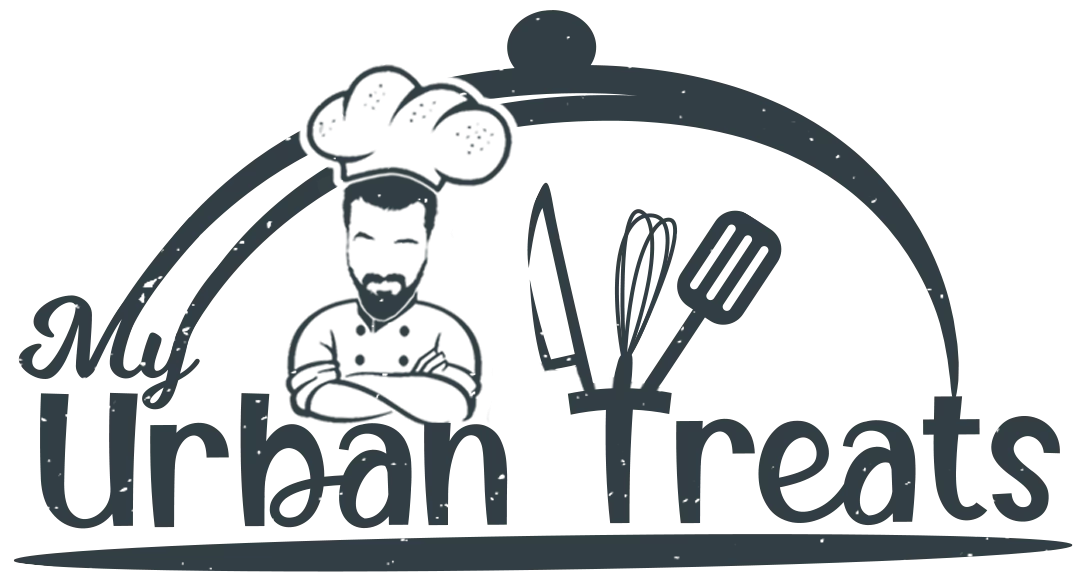Introduction
For those who truly love cooking, a sharp knife is more than a kitchen essential—it’s a non-negotiable. Sharp knives make cooking easier and safer giving you more ease and creativity. But with so many knife sharpeners on the market, how do you choose the one that keeps your blades slicing effortlessly, every time? And is the best sharpener really “the best for you?”
The purpose of this article is to help you in choosing the right knife sharpener that fits seamlessly into your cooking routine. Whether you’re after a quick, effortless solution or you enjoy taking the time to perfect every edge, we’re here to help you find the tool that will keep your knives—and your passion for cooking—sharp and ready for action.
In this article, we will explore three type of sharpeners, Whet Stones which you could call the professional level sharpening tool. All in one manual sharpeners as well as Electric sharpeners.
Disclosure: Some of the sharpeners mentioned in this article were generously provided to me by the manufacturers for testing purposes. However, I want to assure you that no money has been exchanged for advertising, and all opinions expressed here are entirely my own. My goal is to provide honest, unbiased insights to help you make the best choice for your kitchen, without any influence from the brands behind these products.
Overview
In this article, we dive into the world of knife sharpeners, comparing three popular types: whetstones, all-in-one manual sharpeners, and electric sharpeners. Each sharpener offers a unique approach to keeping your knives in peak condition, with varying levels of skill and time required to achieve that perfect edge. Whether you’re a seasoned cook who enjoys the precision and control of sharpening with a whetstone, someone looking for a quick and easy solution with a manual sharpener, or a busy home chef who values the convenience of an electric sharpener, this guide will help you choose the right tool for your kitchen.
By understanding the pros and cons of each option, and considering how much effort you want to invest in maintaining your knives, you’ll be well-equipped to make an informed decision.
Type 1: Whetstones
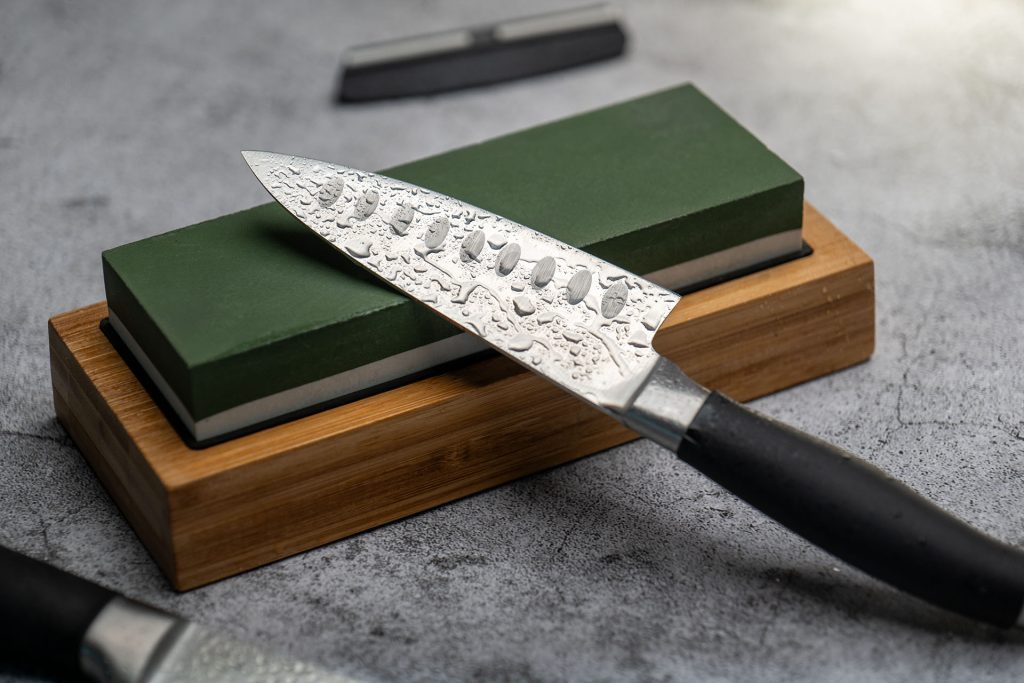
What are Whetstones and how do they work?
Whetstones, also known as sharpening stones, are traditional tools used to sharpen and hone the edges of knives and other cutting instruments. Unlike manual or electric sharpeners, which often have preset angles and guides, whetstones allow for full control over the sharpening process, giving users the ability to fine-tune the angle and sharpness of their blades.
Whetstones work by grinding away small amounts of the knife’s metal, creating a new, sharp edge. The sharpening process involves sliding the knife blade across the stone at a consistent angle, which varies depending on the type of knife and desired sharpness. The stone’s abrasive surface removes tiny metal particles from the blade, sharpening it in the process. To use a whetstone effectively, the user must maintain a steady hand and consistent angle throughout the sharpening strokes.
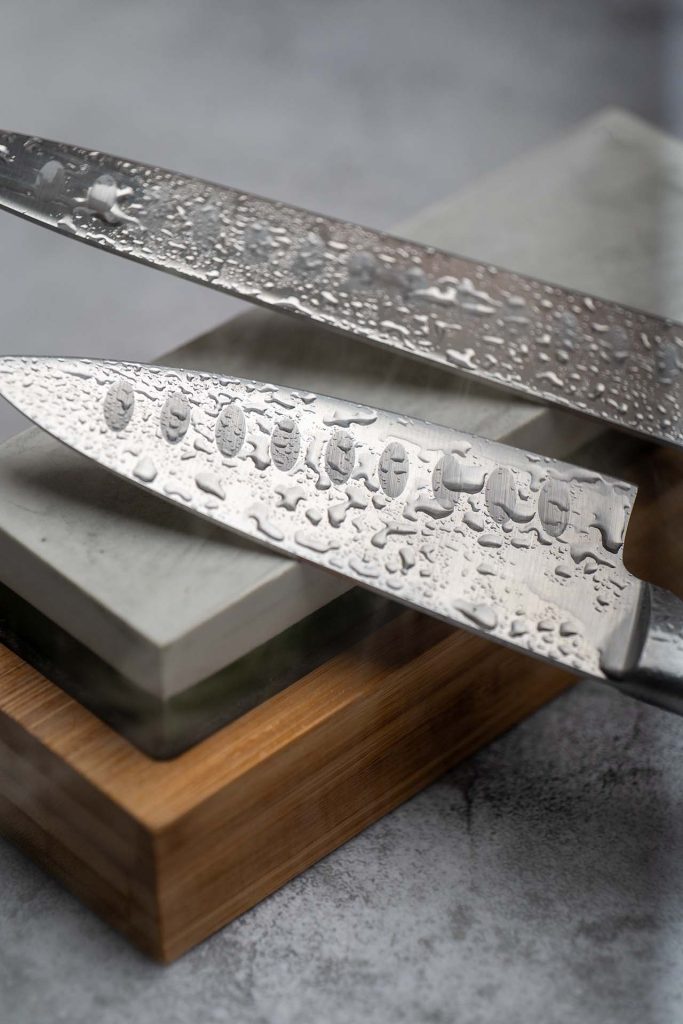
Types of Whetstones
Whetstones come in various types, distinguished by their grit level and material they are made from. Across all material types, whetstones have various grits ranging from coarse (200-600) to fine (3000-8000). The best results are achieved by staring with rougher grids slowing working your way down to a fine grit. Grits 200 to 600 are usually used for fixing chips or damage on blades and can be skipped for maintaining and sharpening an intact knife.
Materials of whetstones are also very important, Waterstones for example are popular, effective and cheap to buy. Oilstones on the other hand are a bit more messy but more durable and last longer. Diamond stones tend to be the highest grade of sharpening stone and very effective with hard steel, they tend to be more expensive.
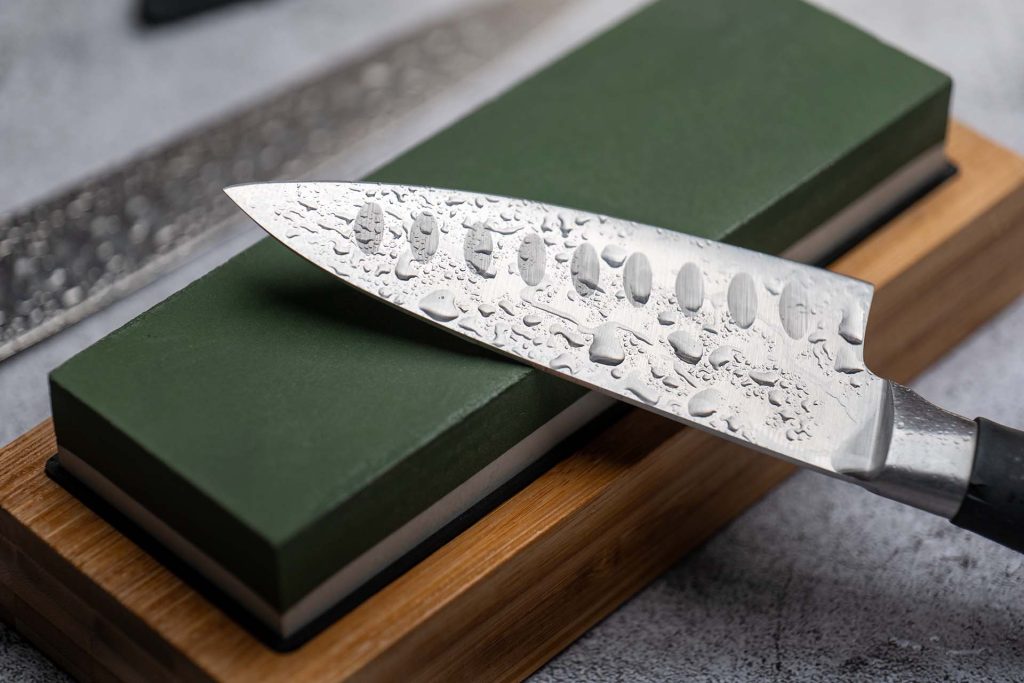
My Experience
I purchased the S SATC Whetstone from Amazon, it came with a 1000 and 6000 side stone as well as an angle clamp, bamboo block and rubber seat. I soaked the stone for the recommended time, the angle clamp helps you maintain the best angle during sharpening although it was not clear what degree the clamp is at, I believe it was around 20 degrees. My first three tries were not great. After a 15-20 minute sharpening cycle I did a tomato test and the blade was almost dull. So I went back to step one, watched a few Youtube Tutorials and tried again. The 4th attempt finally yielded a better result and the knife was able to cut through the tomato with ease.
The difficulties I found were the rounded edges of the blade, keeping the blade at the right angle in one sweeping motion was more challenging than I anticipated. I finally figured out the best way but it was a little nerve racking.
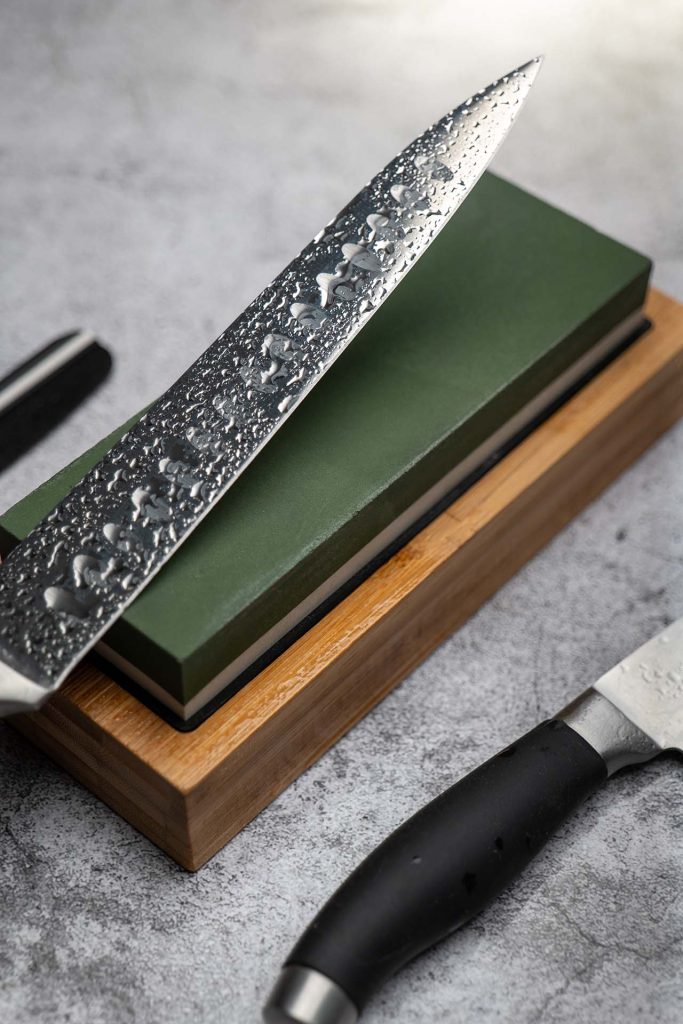
I have put a little rating system together which is not scientific but based on my experience using the product, higher numbers are better:
- Ease of use: 3/10
- Learning Curve: 3/10
- Time: 3/10
- Sharpness: 9/10
- Cost: 7/10
Who is it for?
I would recommend this sharpening method to cooking enthusiasts with DIY skills and time to learn. I would also recommend it to people who are interested in learning this skill as it is a nice skill to have and can be applied on other types of knives as well.
The stones take some space as you need a set of two so consider this before buying if storage space is an issue. Note that if you want a quick solution, this is NOT it.
Where can I buy it?
If you want to help my blog, you can follow my Amazon affiliate links below as it has no extra cost for you but helps me keep the engine running 🙂
Type 2: Pull Through Sharpeners
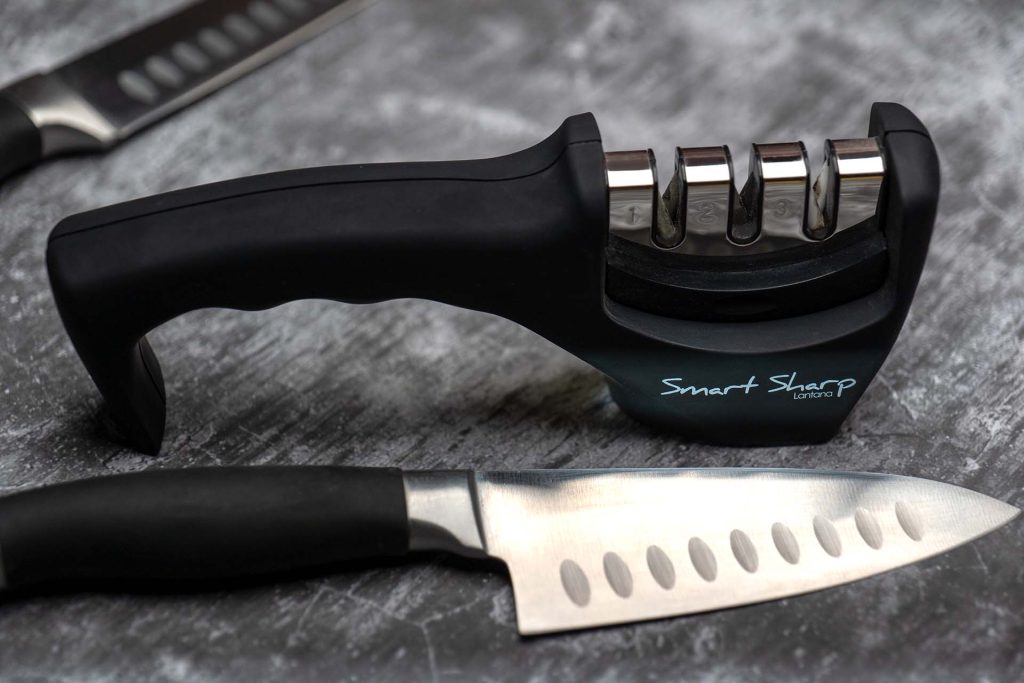
What are pull through sharpeners and how do they work?
Pull Through sharpeners tend to get a bad reputation with knife enthusiasts, this is likely due to cheap products giving a bad reputation to the whole category. But the truth is, you cant expect a 2-3 dollar tool to have great design, manufacturing quality and quality materials that are needed to sharpen hardened steel.
All-in-one manual sharpeners are compact, handheld tools designed to simplify the knife sharpening process. These devices are crafted to offer a convenient, user-friendly way to maintain sharp edges on your kitchen knives without requiring extensive skill or time. They are particularly popular among home cooks who want a quick and effective sharpening solution without the complexities of using a whetstone or the expense of an electric sharpener.
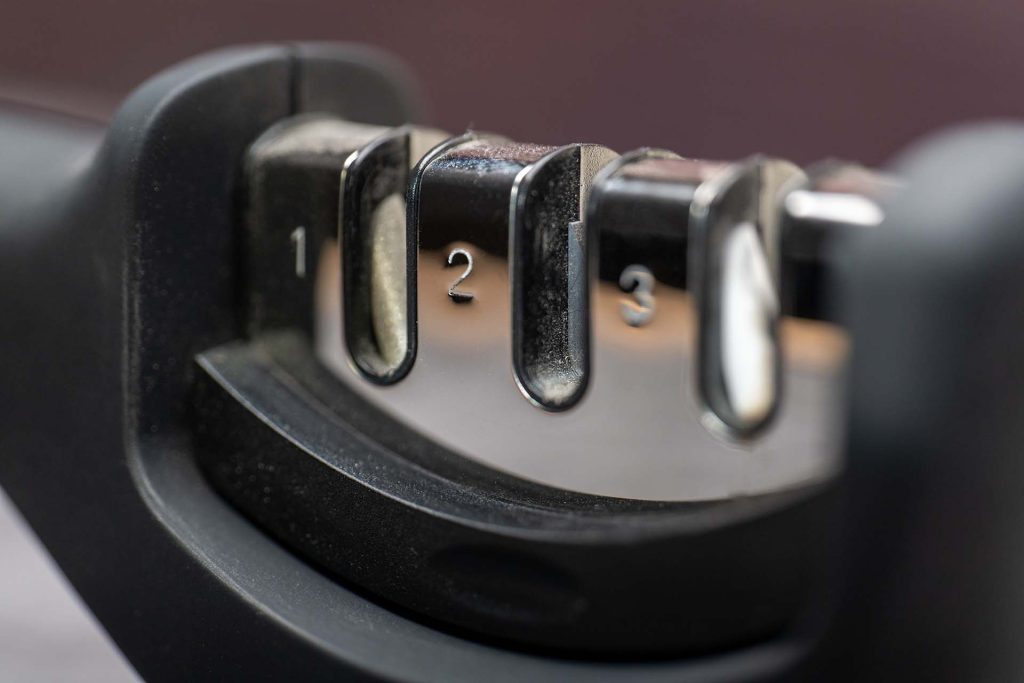
The design of all-in-one manual sharpeners is centred around ease of use and efficiency. What makes pull though sharpeners a good choice? Here are some of the pro’s:
- Compact and Handheld:
- All-in-one or pull through sharpeners are typically small, lightweight, and easy to store in a kitchen drawer or cabinet. Their compact design makes them portable, allowing you to sharpen your knives wherever it’s convenient.
- Pull-Through Slots:
- These sharpeners usually feature one or more pull-through slots, each containing abrasive materials such as ceramic, carbide, or diamond-coated surfaces. The user pulls the knife blade through these slots to sharpen it. Each slot is designed to handle a different stage of sharpening—one for coarse sharpening to repair dull blades and another for fine honing to polish the edge.
- Preset Angles:
- One of the most notable features of all-in-one manual sharpeners is the inclusion of preset sharpening angles within the slots. These angles are carefully chosen to suit the most common types of kitchen knives, ensuring that even beginners can achieve a consistent, sharp edge without worrying about maintaining the correct angle manually. This feature significantly reduces the learning curve and makes the sharpening process almost foolproof.

Overall, all-in-one manual sharpeners are designed for convenience and simplicity, making them an excellent choice for those who want to keep their knives sharp with minimal effort. While they may not offer the precision of a whetstone or the speed of an electric sharpener, they strike a balance that suits many home cooks perfectly.
My Experience
For my all-in-one sharpener test, I got a Smart Sharpener and Smart Sharp Pod from from Lantana Home. This sharpener features a three-stage sharpening system: it starts with diamond rods to remove any imperfections, moves on to tungsten carbide blades that are set at precise angles for sharpening, and finishes with ceramic rods for final honing.
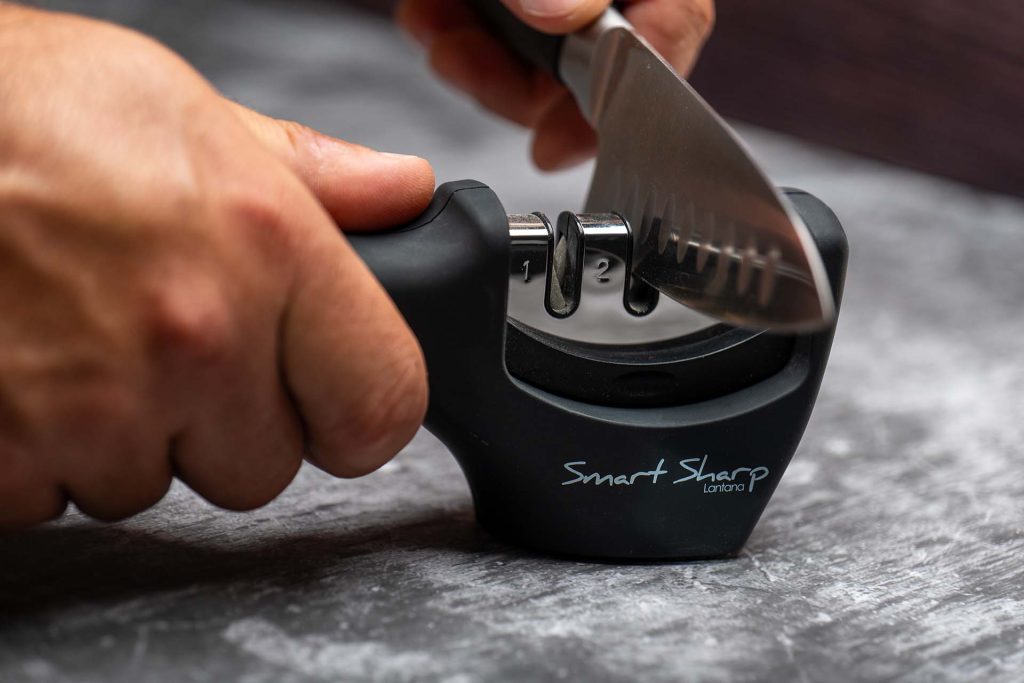
Before diving into my experience, it’s important to highlight a key consideration: while preset angles are fantastic for delivering consistent results, they lack the flexibility needed for different types of knives. For instance, my main kitchen knives are Japanese-style blades sharpened at a 12-degree angle, while most European and American knives are sharpened at a 20-degree angle. So, it’s crucial to check the compatibility of any sharpener with your knife’s angle before using it.
When I first tested the Smart Sharpener, the results were not great but I soon found that this was due to my own mistake. After watching the supplied instructional video I followed all the recommended steps and wow, the result was fantastic. Until this test I always snubbed pull through sharpeners thinking they are a gimmick but boy was I wrong.
- Ease of use: 8/10
- Learning Curve: 9/10
- Time: 8/10
- Sharpness: 7/10
- Cost: 8/10
Overall, the Smart Sharpener proved to be an efficient and user-friendly tool, especially after taking the time to understand how to use it properly. It has cemented itself as a stable in my kitchen tools.
Where can I buy one?
If you want to help my blog, you can follow my Amazon affiliate links below as it has no extra cost for you but helps me keep the engine running 🙂
Type 3: Electric Sharpeners
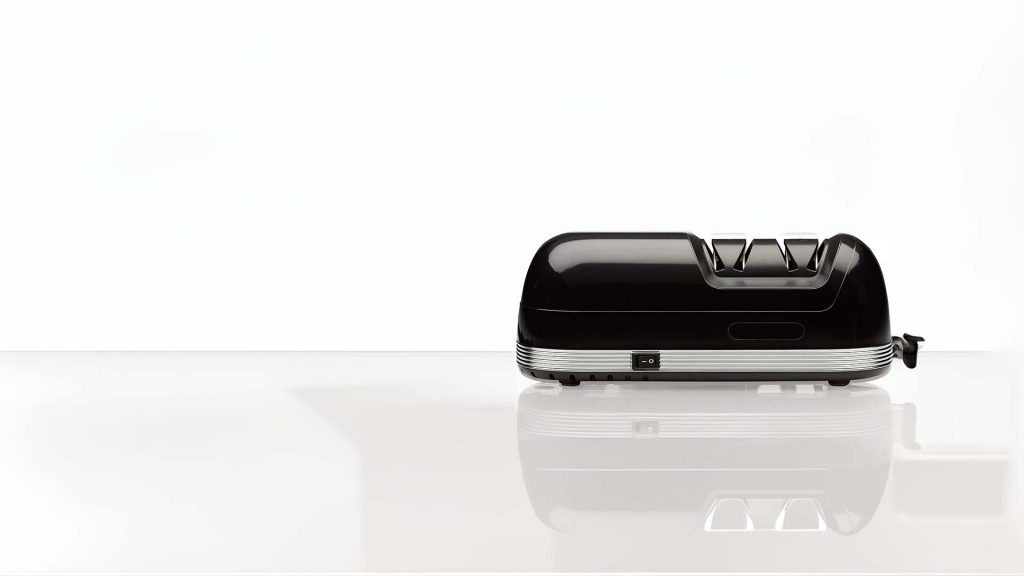
Electric knife sharpeners come in various forms and sizes, some are similar to pull through or manual sharpeners others are more complex such as sharpening stations or belt sanders. This overview is about simple pull through machines and not the more complex ones.
Electric knife sharpeners are convenient, easy-to-use devices designed to keep your kitchen knives sharp with minimal effort. Unlike manual sharpeners or whetstones, which require a bit more skill and time, electric sharpeners do much of the work for you, making them a popular choice for busy home cooks who want a quick and reliable sharpening solution.
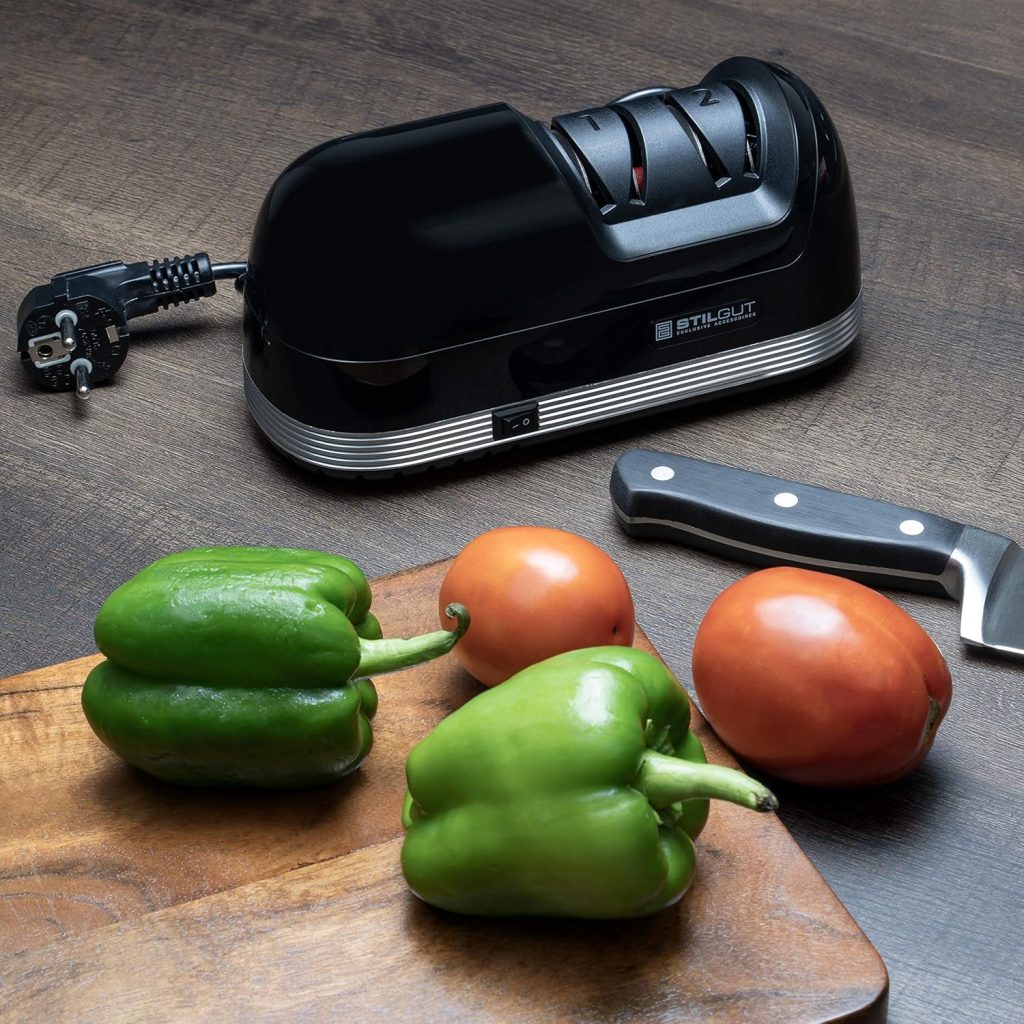
What are Electric Knife Sharpeners and how do they Work?
Electric sharpeners typically feature motorized slots where you insert your knife. Inside these slots are abrasive wheels or belts that spin at high speeds, sharpening your knife as you pull it through. Here’s a closer look at how they operate:
- Motorized Slots: The core of an electric sharpener is its motorized slots. These slots contain the sharpening surfaces—often made of materials like diamond, ceramic, or tungsten—that grind away tiny amounts of metal from the knife’s edge. As you gently pull the knife through the slot, the motor does the heavy lifting, quickly restoring the blade’s sharpness.
- Automatic Angle Adjustment: One of the key benefits of electric sharpeners is their ability to automatically set the sharpening angle. This feature ensures that your knife is sharpened at the optimal angle every time, without requiring you to manually adjust or guess the correct positioning. This is especially useful for those who are new to knife sharpening or don’t want to worry about maintaining a consistent angle.
The sharpener I tested was set at a 15 degree angle which makes a very sharp knife, however I could not sharpen my Japanese knives with it as they are sharpened at 12 degrees and might have been damaged and more dull in the process. - Multi-Stage Sharpening: Many electric sharpeners offer a multi-stage sharpening process. Typically, there are two or three stages:
- Coarse Stage: The first stage is designed to repair and reshape a dull or damaged blade. It uses a coarse grit to remove more metal and create a new edge.
- Medium Stage (optional): Some sharpeners include a medium stage, which further refines the edge, preparing it for the final honing process.
- Fine Stage: The last stage is for honing and polishing the blade, giving it a sharp, smooth edge that’s ready for precise cutting.
With these features, electric knife sharpeners can make it easy to keep your knives in top condition. They’re a great choice if you value speed and consistency, just like pull through sharpeners, they take much of the guesswork out of sharpening.
Just remember to choose a model that’s compatible with your knife type, as not all electric sharpeners are suitable for every blade style.
My Experience
I found that high quality sharpeners can really be worth the extra bucks spent, and here is my reasoning behind this. If you buy a cheap electric sharpener, the results will be similar if not worse than a manual pull through sharpener and you are not really saving that much time.
If you however purchase a high quality machine that makes razor sharp blades then you are now comparing it to a Whetstone and can achieve professional level sharpness, you will however have to fork out a couple of hundred bucks to get a machine that gets close to such results.
Who is it for?
High-end electric sharpeners are for professionals and cooking enthusiasts that value professionally sharpened blades. They are not cheap costing anywhere between 130 and 200 Dollars and are a significant investment. If you are a professional or cook a lot and often need to sharpen your knives or if you are looking for a fast and professional level sharpened solution, then I would recommend this tool. Otherwise a high quality pull through sharpener is the better choice for you.
- Ease of use: 8/10
- Learning Curve: 9/10
- Time: 9/10
- Sharpness: 9/10
- Cost: 2/10
Where can I buy one?
Comparison
| Ease of Use | Learning Curve | Time | Sharpness | Cost | |
| Whetstone | 5/10 | 8/10 | 4/10 | 10/10 | 7/10 |
| Pull Through Sharpener | 9/10 | 5/10 | 8/10 | 7/10 | 9/10 |
| Electric Sharpener | 10/10 | 4/10 | 10/10 | 8/10 | 5/10 |
The Verdict
In the quest for perfectly sharp knives, choosing the right sharpener can make all the difference. Each type of sharpener—whetstones, manual sharpeners, and electric sharpeners—has its own strengths, making it ideal for different users and situations.
Whetstones are the go-to choice for those who value precision and are willing to invest time and skill in their sharpening process. They offer unmatched control over the sharpening angle and can handle all types of knives, making them perfect for professional chefs or knife enthusiasts. However, they require practice and can be time-consuming, so they may not be the best fit for those seeking a quick fix.
Manual sharpeners offer a great balance between ease of use and effectiveness, making them ideal for casual home cooks who want a straightforward, low-maintenance option. They are compact, affordable, and easy to use, but their preset angles might not suit every type of knife, particularly specialty blades like Japanese knives.
Electric sharpeners are all about convenience and speed, making them perfect for busy home chefs who need to maintain multiple knives with minimal effort. They deliver consistent results with little skill required, thanks to their motorized slots and automatic angle adjustment. However, they can be bulky, more expensive, and less versatile when it comes to sharpening angles, which might not appeal to those with a diverse collection of knives.
In the end, the right sharpener for you depends on your specific needs, how much time and effort you’re willing to dedicate to sharpening, and the types of knives you use. Each tool has its place in the kitchen, and understanding their pros and cons will help you make the best choice for your culinary needs.
